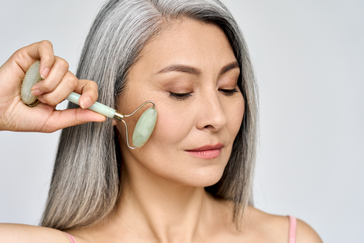What Is Skin Regeneration?
Posted by Mike Miryala on

Our skin cells are constantly replacing themselves, and this happens through the process of regeneration and repair.
In other words, the skin cells are constantly shedding, revealing fresh new cells underneath. This is one reason why blemishes and scars may fade with time.
When you understand the science behind your skin’s life cycle, it would help you take care of your skin better, especially during the stages of regeneration.
More so, understanding this science helps you know to support or boost your skin’s natural regeneration process to achieve a fresh glow.
Now, let’s start from the basics.
What is Skin Regeneration?
Skin regeneration simply means the complete replacement of damaged tissue with new skin tissue, while the continued healing of existing tissue is known as skin repair.
However, skin regeneration is not usually linked with scar tissue. Instead, the process happens in two ways:
- Replacement of tissues that are already torn down
- Putting together or restoration of what is broken
Skin regeneration occurs on a cellular level. And according to research, the epidermis, or top layers of the skin replace themselves continuously.
The epidermis of the skin is actually maintained by stem cells located in the lower layers of the skin. These stem cells produce daughter cells that move to the surface of the skin.
During this movement, the cells responsible for keratin production go through a series of morphological and biochemical changes, resulting in the formation of various skin layers. This gives your skin a young, healthy glow.
The Process of Skin Regeneration

Studies have shown that the skin turns over every 40 to 56 days. The process of exfoliation occurs quite naturally when we’re young, but as we grow older, the process slows down.
In fact, studies show that by age 80, the usual 28-day skin turnover time increases by 30-50% approximately.
For people who are above age 50, the process of skin regeneration can take as long as 84 days. This slow process produces effects that cause buildup and excess dead skin cells. This makes the skin look dull, tired, and opaque.
However, the process of skin regeneration involves two major things on a cellular level:
- New skin cells form deep in the epidermis
- Skin cells become mature and die on the upper layer of the epidermis, and then they fall away naturally.
The Process of Skin Healing
Most times, a cut or burn tends to produce a scar. This is mainly because the fibroblast in scar tissue forms a different kind of collagen other than that in regular tissue. So, the scar is thicker and less flexible than your regular skin tissue.
Studies have shown, however, that by improving skin regeneration, scars can fade away gradually, as new healthy skin tissues are produced beneath.
Now, the question is, “how can you boost skin regeneration naturally?”
How to Improve Skin Regeneration
As mentioned earlier, the process of skin regeneration slows down as we grow older, and this often leads to the accumulation of dead skin cells on the top skin layer.
Luckily, you can boost the process of skin regeneration naturally. This way, you can help your skin look fresh and feel elastic, even as you grow older.
Without much ado, check out these natural measures:
Lifestyle Choices
Making some slight adjustments in your lifestyle choices can help boost the process of skin regeneration. Some good choices to adopt include:
- Regular exercise
- Staying hydrated
- A nutrient-dense diet
- Reducing stress
- Protecting your skin from environmental factors, such as UV rays, dry weather, and pollution.
Aging comes in two forms – intrinsic or cellular aging and extrinsic or environmental aging.
Intrinsic aging is influenced by genetic factors and it occurs naturally. More so, this form of aging may increase with stress. Extrinsic aging is influenced by outside factors, such as lifestyle factors and where you live.
That said, health experts and nutritionists recommend eating plenty of protein, such as beans, fish, nuts and seeds, and poultry. The body cells need protein for tissue repair and building of new tissue.
Also, foods high in antioxidants boost skin regeneration. Some good examples include strawberries, blueberries, turmeric, ginger, and apples. Adding antioxidant-rich foods to your diet helps boost your skin glow.
Skincare Products

There are thousands of skincare products in the market, but it is advisable to choose products containing beneficial ingredients, such as vitamin B3, vitamin C, vitamin E, hyaluronic acid, and alpha-lipoic acid (ALA).
These ingredients help improve the natural cell turnover process, get rid of build-up dead skin cells, and hydrate your skin.
Vitamin B3, for example, is a necessary component of cell metabolism, and it is required for many skin processes that support a healthy-looking skin.
Vitamin C and vitamin E are also strong antioxidants that help to prevent cellular damage caused by free radicals.
Apart from commercial products, some natural remedies you can try to support skin regeneration include:
- Jojoba oil
- Papaya extract
- Coconut oil
- Rosehip oil
- Citrus extracts, like orange peel
One study showed that plant extracts, including papaya, showed great antioxidant and anti-wrinkle effects.
Another study found that rosehip, jojoba, and coconut oil are great for skin barrier repair, anti-aging, and wound healing.
You also use orange peel extracts as it has been shown to provide useful protection against damages caused by UV rays.
How Long Does it Take Your Skin to Regenerate?
For younger people below age 50, it may take between 28 and 42 days for the skin to completely regenerate. But for older adults above age 50, this process may take up to 84 days or more.
However, several factors determine how long it takes for your skin to regenerate. These factors include:
- Your diet
- Your age
- Your hydration level
- Your skincare routine
- Environmental factors
Final Remark
Skin regeneration is a natural process that causes dead skin cells on the epidermal or top skin layer to fall away, allowing fresh, newly formed cells to be revealed.
Adjusting your lifestyle habits and maintaining a good skincare routine is a good way to support skin regeneration to achieve a lustrous glow even as you grow older.
But keep in mind that the cycle may slow down as you age. You may develop wrinkles and weaker skin texture as you grow older.
Luckily, you may consider adding collagen supplements to your diet to reduce wrinkles, clear dark spots, and even strengthen your joints.
Check out Indulgence Collagen Powder -- a delicious Chocolate Treat loaded with grass-fed collagen and 6 other powerful superfoods to help you look and feel younger.

Mike Miryala, Head Pharmacist at CoBionic
You might also like:
Indulgence Vanilla Collagen
- A Delicious Vanilla Treat Loaded With Collagen and 5 other Powerful Superfoods like Silica and Glucomannan
- Reduced wrinkles and fine lines
- Supports stronger, fuller hair
- Great for both gut and joint health
YouthBoost Hair & Skin Gummies
- Deliciously sweet melt-in-your-mouth gummies that are vegetarian, gluten-free, & low in sugar to deliver vitamins and nutrients
- Supports fuller, longer, more vibrant hair
- With vitamins that keep skin youthful and firm
- With nutrients that maintain healthy, strong, growing nails








